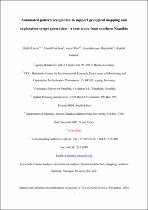 ResearchSpace
ResearchSpace
Automated pattern recognition to support geological mapping and exploration target generation: a case study from southern Namibia
JavaScript is disabled for your browser. Some features of this site may not work without it.
- ResearchSpace
- →
- Research Publications/Outputs
- →
- Journal Articles
- →
- View Item
| dc.contributor.author |
Eberle, D

|
|
| dc.contributor.author |
Hutchins, D

|
|
| dc.contributor.author |
Das, Sonali

|
|
| dc.contributor.author |
Majumdar, A

|
|
| dc.contributor.author |
Paasche, H

|
|
| dc.date.accessioned | 2015-08-17T13:08:56Z | |
| dc.date.available | 2015-08-17T13:08:56Z | |
| dc.date.issued | 2015-06 | |
| dc.identifier.citation | Eberle, D, Hutchins, D, Das, S, Majumdar, A and Paasche, H. 2015. Automated pattern recognition to support geological mapping and exploration target generation: a case study from southern Namibia. Journal of African Earth Sciences, vol. 106, pp 60-74 | en_US |
| dc.identifier.issn | 1464-343X | |
| dc.identifier.uri | http://ac.els-cdn.com/S1464343X15000515/1-s2.0-S1464343X15000515-main.pdf?_tid=fe13e02c-3a8d-11e5-9a39-00000aacb360&acdnat=1438681903_9f8574fee2d8e397c675253e45214a8a | |
| dc.identifier.uri | http://hdl.handle.net/10204/8010 | |
| dc.description | Copyright: 2015 Elsevier. This is a pre-print version. The definitive version of the work is published in the Journal of African Earth Sciences, vol. 106, pp 60-74 | en_US |
| dc.description.abstract | This paper demonstrates a methodology for the automatic joint interpretation of high resolution airborne geophysical and space-borne remote sensing data to support geological mapping in a largely automated, fast and objective manner. At the request of the Geological Survey of Namibia (GSN), part of the Gordonia Subprovince of the Namaqua Metamorphic Complex situated in southern Namibia was selected for this study. | en_US |
| dc.language.iso | en | en_US |
| dc.publisher | Elsevier | en_US |
| dc.relation.ispartofseries | Workflow;15007 | |
| dc.subject | Cluster analysis | en_US |
| dc.subject | Discriminant analysis | en_US |
| dc.subject | Lineament detection | en_US |
| dc.subject | Mapping | en_US |
| dc.subject | Southern Namibia | en_US |
| dc.subject | Namaqua Metamorphic Belt | en_US |
| dc.title | Automated pattern recognition to support geological mapping and exploration target generation: a case study from southern Namibia | en_US |
| dc.type | Article | en_US |
| dc.identifier.apacitation | Eberle, D., Hutchins, D., Das, S., Majumdar, A., & Paasche, H. (2015). Automated pattern recognition to support geological mapping and exploration target generation: a case study from southern Namibia. http://hdl.handle.net/10204/8010 | en_ZA |
| dc.identifier.chicagocitation | Eberle, D, D Hutchins, Sonali Das, A Majumdar, and H Paasche "Automated pattern recognition to support geological mapping and exploration target generation: a case study from southern Namibia." (2015) http://hdl.handle.net/10204/8010 | en_ZA |
| dc.identifier.vancouvercitation | Eberle D, Hutchins D, Das S, Majumdar A, Paasche H. Automated pattern recognition to support geological mapping and exploration target generation: a case study from southern Namibia. 2015; http://hdl.handle.net/10204/8010. | en_ZA |
| dc.identifier.ris | TY - Article AU - Eberle, D AU - Hutchins, D AU - Das, Sonali AU - Majumdar, A AU - Paasche, H AB - This paper demonstrates a methodology for the automatic joint interpretation of high resolution airborne geophysical and space-borne remote sensing data to support geological mapping in a largely automated, fast and objective manner. At the request of the Geological Survey of Namibia (GSN), part of the Gordonia Subprovince of the Namaqua Metamorphic Complex situated in southern Namibia was selected for this study. DA - 2015-06 DB - ResearchSpace DP - CSIR KW - Cluster analysis KW - Discriminant analysis KW - Lineament detection KW - Mapping KW - Southern Namibia KW - Namaqua Metamorphic Belt LK - https://researchspace.csir.co.za PY - 2015 SM - 1464-343X T1 - Automated pattern recognition to support geological mapping and exploration target generation: a case study from southern Namibia TI - Automated pattern recognition to support geological mapping and exploration target generation: a case study from southern Namibia UR - http://hdl.handle.net/10204/8010 ER - | en_ZA |





